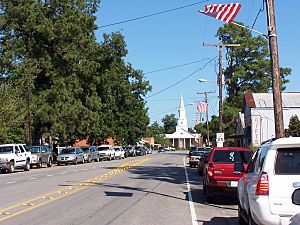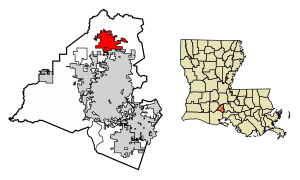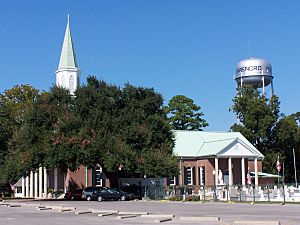Carencro, Louisiana facts for kids
Quick facts for kids
Carencro, Louisiana
de Carencro
|
|
|---|---|
| City of Carencro | |

Downtown Carencro
|
|

Location of Carencro in Lafayette Parish, Louisiana.
|
|

Location of Louisiana in the United States
|
|
| Country | United States |
| State | Louisiana |
| Parish | Lafayette |
| Area | |
| • Total | 7.86 sq mi (20.35 km2) |
| • Land | 7.86 sq mi (20.35 km2) |
| • Water | 0.00 sq mi (0.00 km2) |
| Elevation | 39 ft (12 m) |
| Population
(2020)
|
|
| • Total | 9,272 |
| • Density | 1,180.24/sq mi (455.69/km2) |
| Time zone | UTC-6 (CST) |
| • Summer (DST) | UTC-5 (CDT) |
| ZIP code |
70520
|
| Area code(s) | 337 |
| FIPS code | 22-12665 |
| Website | Carenco, Louisiana |
Carencro (pronounced CARE-en-crow) is a city in Lafayette Parish, Louisiana, in the United States. It's a suburb of the bigger city of Lafayette. In 2020, about 9,272 people lived there. The name Carencro comes from a Cajun French word for buzzard or vulture. Long ago, many vultures would gather in the bald cypress trees in this area. The name means "carrion crow," referring to these birds. Carencro is part of the larger Lafayette metropolitan area.
Contents
The Story Behind Carencro's Name
Many older residents of Carencro say the town's name comes from a story told before the American Civil War. According to this local legend, Native Americans told early settlers that a long time ago, many "carrion crows" (which are actually vultures, called carencro in French) gathered near the Vermilion River. They were there to eat fish that had died.
There's another idea about the name. It might come from the carencro tête rouge, which means "red-headed buzzard." European explorers wrote about this bird as early as 1699. They described it as a black bird with a red head. The Spanish government protected these birds because they ate what was left of animals like buffalo. This kept the air clean by preventing rotting carcasses from smelling bad.
In 1802, Martin Duralde, a former leader of the Opelousas area, shared a legend from an Attakapas Indian. The story said that a very large animal had died in or near a bayou (a slow-moving stream). The exact spot was forgotten over time. This legend might refer to a mastodon, a huge animal similar to an elephant, that died out thousands of years ago.
A story from the late 1800s said that the buzzards were feasting on a mastodon carcass. Its fossilized bones were supposedly found by a French naturalist in the 1700s. He tried to send them to Paris, but the ship sank, and the bones were lost. Only a leg bone was saved by an early settler, who used it to crush indigo for dye. The Native Americans called the birds carecros, and the river near where the mastodon died became known as Bayou Carencro.
The town was first called St. Pierre. But in the late 1800s, it was renamed Carencro because of this "carrion crow" (vulture) legend. Even though Carencro's center is now west of the Vermilion River, this story is still an important part of the community's history.
Some people also think the name comes from the Spanish word carnero, which means "bone pile." This idea also connects to the mastodon legend, suggesting the buzzards left only a pile of white bones.
Carencro's Early Days
First Settlers in Carencro
Not many European people lived in the Carencro area until the Acadian refugees arrived in the 1700s. Some Acadians who came in 1765 were given land along Bayou Carencro. Early settlers like Jean and Marin Mouton, Charles Peck, and Louis Pierre Arceneaux started cattle farms (called vacheries) nearby. More cattle ranchers came after 1770. At that time, the Spanish governor said that to get a large piece of land, you needed to own 100 tame cattle, some sheep and horses, and two enslaved people to manage them.
In 1769, government officials visited the area and reported that people had "everything imaginable in the way of livestock." A Frenchman visiting in 1793 saw thousands of cattle on the prairies.
Besides the Mouton family, other early settlers in the Carencro area included Charles Peck, Traveille Bernard, Rosamond Breaux, Ovignar Arceneaux, and the Babineaux family. A count in 1803 listed many family names in the Carencro area, such as Arceneaux, Benoit, Bernard, Breaux, Cormier, Guilbeaux, and Mouton.
Connecting Carencro: Post Office and Phones
The first post office in Carencro opened on January 11, 1872. Auguste Melchior was the first postmaster. A telegraph line reached the town in 1884, allowing faster communication. The first telephones were installed in 1894 by the Teche and Vermilion Telephone Line company.
Historic Churches of Carencro
The Catholic Church in Carencro started by being served from other nearby towns. The parish of St. Peter was officially created in 1874. Father Andre Marie Guillot became its first pastor. Before a church building was ready, services were held in the Carmouche blacksmith shop. The church was first called St. Pierre au Carencro, named after Pierre Cormier, who donated the land for the first church. Father Guillot sadly died of yellow fever while serving in Carencro and was buried in the church cemetery.
After Father Guillot, Father J.F Suriray took over. However, he had problems with the people and had to leave. Later, the church was destroyed by fire, and the parish didn't have a pastor until 1883.
A plaque outside the current church says the land was donated by the Jean Jacques Coussan family. A new church was built in 1893, but it was destroyed by a tornado before it could even be used. Another church was built, but it burned down in 1904. The church building you see today was built in 1906. Father F.J. Grimeaux led the parish for about 25 years and even started the Carencro Brass Band, playing clarinet in it himself.
A young carpenter named Hector Connolly helped build the tall, 110-foot steeple for the church.
The Church of the Assumption was built in 1925 to serve the Black community. The Holy Ghost Fathers were invited to lead the parish, and Father Joseph Dolan became the first pastor. Assumption Church still stands today with its original structure. It's the only white, wood-frame church of its kind in the Diocese of Lafayette.
The Our Lady of the Assumption Religious Complex includes the church, the rectory (where the priest lives), the school, Drexel Parish Hall, the church cemetery, and the St. Katharine Drexel Shrine. This whole complex was added to the State and National Register of Historic Places in 2001.
Carencro's Schools Through Time
In 1870, Auguste Melchior, a Frenchman from New Orleans, became the director of education for Lafayette Parish. In 1874, what was likely the first school in Carencro opened on his farm. His wife, Viviana Carencro, taught at this village school.
By 1889, Carencro had two private schools. Charles Heichelheim, a German, ran a school for boys. Edmond Villére ran a school for both boys and girls. That same year, the first public school was built in Carencro. A second floor was added 10 years later. This school became an approved high school around 1917.
Around 1897, the Sisters of Mount Carmel opened St. Ann's School of Carencro.
Assumption School was built in 1932. Teachers from the Sisters of the Blessed Sacrament worked there. This school brought together Black students from several smaller Catholic schools in the area. The school received money from Saint Katharine Drexel of New Orleans.
After the 1950s, the Sisters of the Blessed Sacrament also taught at Carencro Catholic School. In the early 1980s, students from Assumption School and St. Pierre School combined to form the current Carencro Catholic School.
Growing Economy in Carencro
Newspapers in the late 1800s reported on Carencro's growth. In 1879, The Opelousas Courier said, "This little village is rapidly expanding." It also mentioned that the church grounds had new fences made of iron wire and steel barbs, making them strong barriers.
The newspaper also noted that the village of St. Pierre (Carencro) was growing quickly with many buildings and businesses. It said, "Many beautiful stores... are established there."
By 1889, Carencro had two sugar factories. In 1894, the Carencro Sugar Company was formed to build another sugar mill. However, the sugar mills in the area closed around 1900.
Before 1876, Carencro had several cotton gins that used horse power. In 1876, Avignac Arceneaux built the first steam-powered cotton gin in the parish. More gins were built in the late 1880s and 1890s. In 1889, 1,800 bales of cotton were shipped from Carencro. Cotton gins continued to operate in Carencro until the mid-1970s.
Important People and Businesses
In 1891, a historian named William Henry Perrin said that Carencro was a very pretty place for a town with many good advantages.
Some of the main business owners in the 1890s included the Brown Brothers, Jacob Mitchell, D. Daret, and A.G. Guilbeau.
People who owned large farms near the town included Mrs. Z. Broussard, Dr. R.J. Francez, and Mrs. O.C. Mouton. Charles J. Richard opened the town's lumberyard along the Southern Pacific Railroad. This business closed in 1985 during a tough economic time.
Carencro Today
Carencro's St. Peter's Catholic Church and its cemetery are a beautiful part of the town. St. Peter's Catholic Church has a fancy entrance, altar, and other parts carved from cypress wood. It also has unique designs on the ends of its pews. These designs were created by Catholic priests. Long ago, pews were "sold" to church members to help raise money for the church.
Important people from Carencro, like former postmaster William J. Broussard and former lumberyard owner Oliver Richard, are buried in this cemetery. Carencro's cemetery has above-ground graves. This is different from areas closer to the Atchafalaya Basin or south of Baton Rouge, where graves are often above ground in mausoleums because the ground is very wet.
The City Hall and Fire Station complex is a modern building that contrasts with the traditional Catholic church. It was designed by local architect Lynn Guidry and can be seen on Church Street.
Geography of Carencro
Carencro is located at 30°18′51″N 92°2′37″W / 30.31417°N 92.04361°W. It has an elevation of about 39 feet (12 meters) above sea level. The United States Census Bureau says the city covers a total area of about 6.1 square miles (15.8 square kilometers), and all of it is land.
Population and People
| Historical population | |||
|---|---|---|---|
| Census | Pop. | %± | |
| 1890 | 289 | — | |
| 1900 | 445 | 54.0% | |
| 1910 | 609 | 36.9% | |
| 1920 | 630 | 3.4% | |
| 1930 | 684 | 8.6% | |
| 1940 | 914 | 33.6% | |
| 1950 | 1,587 | 73.6% | |
| 1960 | 1,519 | −4.3% | |
| 1970 | 2,302 | 51.5% | |
| 1980 | 3,712 | 61.3% | |
| 1990 | 5,429 | 46.3% | |
| 2000 | 6,120 | 12.7% | |
| 2010 | 7,526 | 23.0% | |
| 2020 | 9,272 | 23.2% | |
| U.S. Decennial Census | |||
| Race | Number | Percentage |
|---|---|---|
| White (non-Hispanic) | 4,002 | 43.16% |
| Black or African American (non-Hispanic) | 4,339 | 46.8% |
| Native American | 24 | 0.26% |
| Asian | 88 | 0.95% |
| Pacific Islander | 6 | 0.06% |
| Other/Mixed | 326 | 3.52% |
| Hispanic or Latino | 487 | 5.25% |
In 2020, there were 9,272 people living in Carencro. There were 3,533 households and 1,980 families. The population was made up of different groups: about 43.16% White (not Hispanic), 46.8% Black or African American, and smaller percentages of other groups. About 5.25% of the population was Hispanic or Latino.
In 2000, there were 6,120 people. About 39.8% of households had children under 18. The average household had 2.66 people. The median age was 33 years old. About 30.2% of the population was under 18.
The median income for a household in 2000 was $22,716. About 29.8% of the population lived below the poverty line. This included 42.6% of those under 18 and 27.1% of those 65 or older.
Sister Cities
Carencro has two sister cities, which means they have special friendly relationships:
- Dieppe, New Brunswick, Canada
- Leuze-en-Hainaut, Belgium
See also
 In Spanish: Carencro para niños
In Spanish: Carencro para niños




